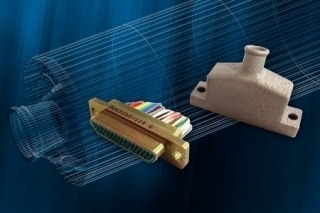Mar 21 2016
The Fleet Ballistic Missile program from the U.S. Navy have successfully conducted test flights of three Trident II D5 Fleet Ballistic Missiles, featuring a first-of-its-kind 3D-printed missile component known as a connector backshell.
 3D-printed connector backshell flew in a Trident II D5 fleet ballistic missile test flight March 16. The connector backshell is shown at right next to the cable assembly to which it connects in the missile. Digital engineering cut in half the time to design and fabricate the part. (Photo: Lockheed Martin.)
3D-printed connector backshell flew in a Trident II D5 fleet ballistic missile test flight March 16. The connector backshell is shown at right next to the cable assembly to which it connects in the missile. Digital engineering cut in half the time to design and fabricate the part. (Photo: Lockheed Martin.)
The new 3D-printed missile component was designed and fabricated by Lockheed Martin engineers, using advanced digital processes that took half the time of conventional methods for fabrication. An aluminum alloy was used to fabricate the connector backshell, measuring roughly an inch across. The function of the connector is to provide protection to the cable connectors in the missile.
The Lockheed Martin-built D5 missile is recognized as the most reliable large ballistic missile in the world, successfully completing 160 test flights since its design completion in 1989. Unarmed missiles were launched from a submerged submarine in the most recent tests conducted in the Atlantic Ocean. Lockheed Martin-built kits containing flight telemetry instrumentation and various safety devices were used to convert the missiles into test configurations. The test flights were conducted as part of a Follow-on Commander’s Evaluation Test of the Trident Strategic Weapon System under the testing guidelines of the Joint Chiefs of Staff.
These tests demonstrate the readiness and reliability of this crucial system that protects what matters most for the nation. The Trident Strategic Weapon System stands guard every minute of every day, thanks to the dedication and forward thinking of the Navy program office, the submarine crews and the industry team.
Eric Scherff, Vice President, Fleet Ballistic Missile programs, Lockheed Martin Space Systems
The 3D-printed component designed for the D5 missile is an illustration of the optimized products and processes made possible with Lockheed Martin’s Digital Tapestry, which is a set of sophisticated manufacturing tools that links the digital life of a product from concept to production to sustainment. Lockheed Martin also has developed 3D-printed components for use on satellites, planetary probes, and spacecraft for human use.
The U.S. Navy Ohio-class and U.K. Royal Navy Vanguard-class submarines have the Trident II D5 missiles onboard to prevent nuclear aggression. The three-stage ballistic missile is capable of traveling a nominal range of 4,000 nautical miles and carrying different independently targeted reentry bodies.
The D5 is the sixth in a series of missile generations deployed since the launch of the sea-based deterrent program. Lockheed Martin has been serving as the strategic missile prime contractor for the U.S. Navy since 1955, being part of one of the longest government and industry collaborations for a major U.S. weapon system. Under the Polaris Sales Agreement, the company is also involved in program management and engineering services for the Royal Navy.